Translation Google
Increase in diphtheria cases caused by C. diphtheriae in France in 2022
Update on November 30, 2022 following cases of diphtheria caused by C. diphtheriae reported in several regions of metropolitan France as well as in Mayotte and Réunion.
Posted on December 29, 2022
Since the beginning of 2022, several cases of diphtheria have been reported in 9 regions of metropolitan France as well as in Mayotte and Réunion. Compared to other years, the number of cases of C. diphtheriae is significantly higher than average. In metropolitan France, the majority of cases were reported in migrants and travelers. Thanks to the very high vaccination coverage for many years, the occurrence of serious cases or clustered cases within the general population appears extremely low in metropolitan France and Reunion. In Mayotte, where vaccination coverage is insufficient, the bacterium has been circulating for several years.
Public Health France is monitoring the evolution of the situation and the increase in cases of diphtheria among migrants, the vast majority of whom are not up to date with their vaccinations. A reminder of vaccination and management recommendations has been sent to associations and healthcare professionals.
Reminder about illness
Diphtheria is a disease caused by bacteria ( Corynebacterium diphtheriae ). Very contagious, it is transmitted from person to person from sick subjects but also from healthy carriers (carrying possible for several weeks or months). Transmission is either direct by coughing and sneezing (via droplets), or indirect from soiled objects (rare) or untreated skin lesions. Its incubation period is short, 2 to 5 days. The signs of diphtheria are those of sore throat, with fever, swelling of the neck and headache or skin infection.
Update in France
As of November 30, 2022, 55 cases of diphtheria have been reported in France since the start of the year (figure 1):
Figure 1 - Number of reported diphtheria cases, per year, France, 2002-2022 – Data as of November 30, 2022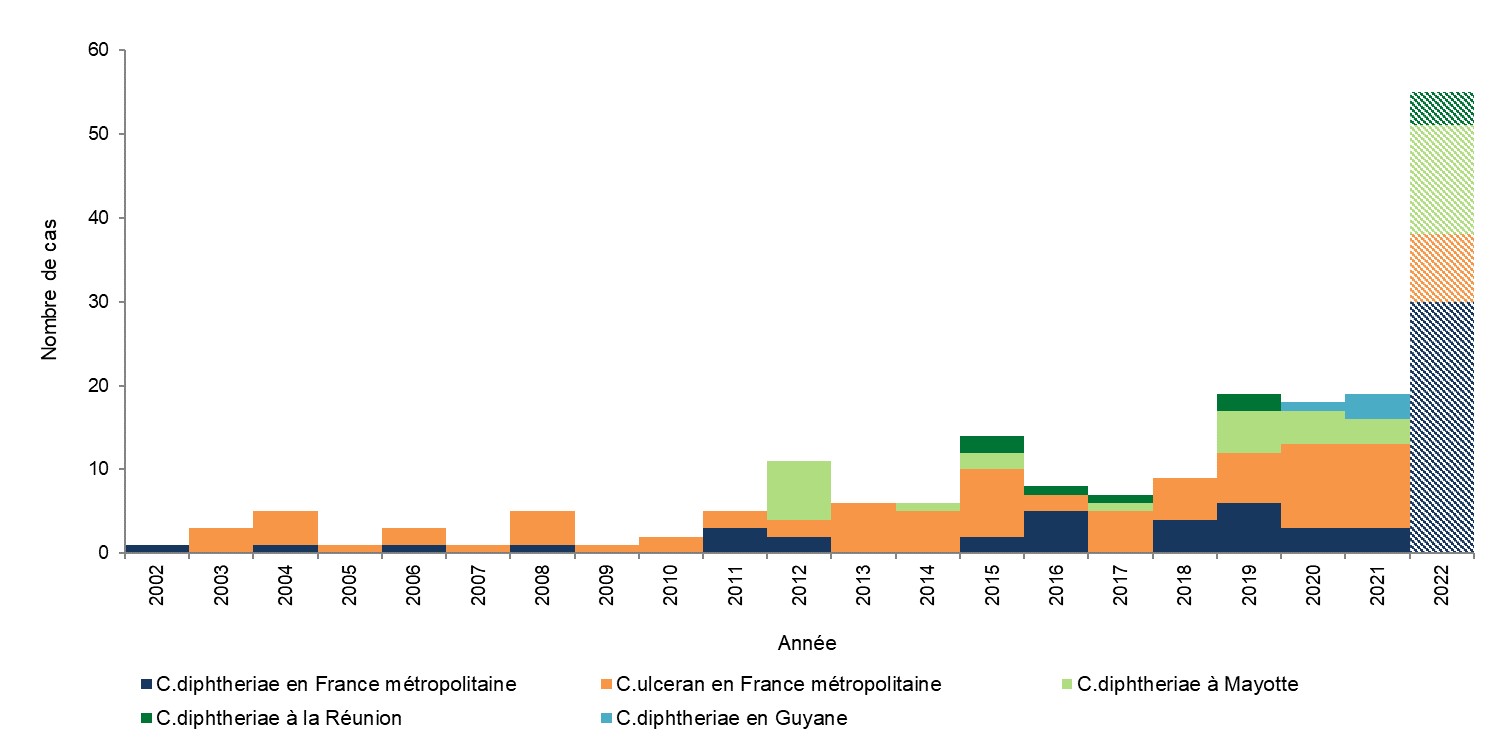
In France
The majority of cases were reported in migrants (n=24) but also in travelers (n=5) (Figure 2). For these 29 cases, a link was found with one or more of the following countries: Afghanistan (n=21), Turkey (n=6), Italy (n=5), Serbia (n=5), Austria (n= 4), Tunisia (n=3), Bulgaria (n=2), Iran (n=2), Hungary (n=2), Mali (n=2), Switzerland (n=2), Slovenia (n=1 ), Syria (n=1), Senegal (n=1), Thailand (n=1). When the date of their arrival in France was known (n=9), it was less than 15 days before the date of notification of the disease.
In addition, a case was probably infected on French territory during contact with a person returning from a trip to Togo.
Cases of diphtheria due to C. diphtheriae were mainly men (n=28), aged 11 to 47 years (21 years on average). Only two of them were up to date with their diphtheria vaccination. For 24 of them, the vaccination status was unknown.
Among the cases that occurred among migrants, 6 lived in a shelter.
Cases have been diagnosed in 9 regions. The Normandy region was the most affected with 7 cases reported (figure 3). Twenty-five cases were cutaneous forms, 3 were asymptomatic carriers (oropharyngeal), one was a slightly symptomatic respiratory form (autochthonous case) and another presented the symptoms of classic respiratory diphtheria (migrant person).
Two grouped cases were reported: one concerned 4 cases who had traveled together on a bus and the other two cases who had traveled together.
Genotyping of 19 isolates by the National Reference Center (CNR) for corynebacteria of the diphtheriae complex by genomic sequencing showed 5 different genetic groups: ST377a (2 cases), ST377b (1 case), ST384 (2 cases), ST574 ( 3 cases), ST698 (2 cases). These groups have also been identified in other European countries. The other isolates are being sequenced.
Figure 2 - Number of diphtheria cases caused by C. diphtheriae, by reporting week, France, 2022 – Data as of November 30, 2022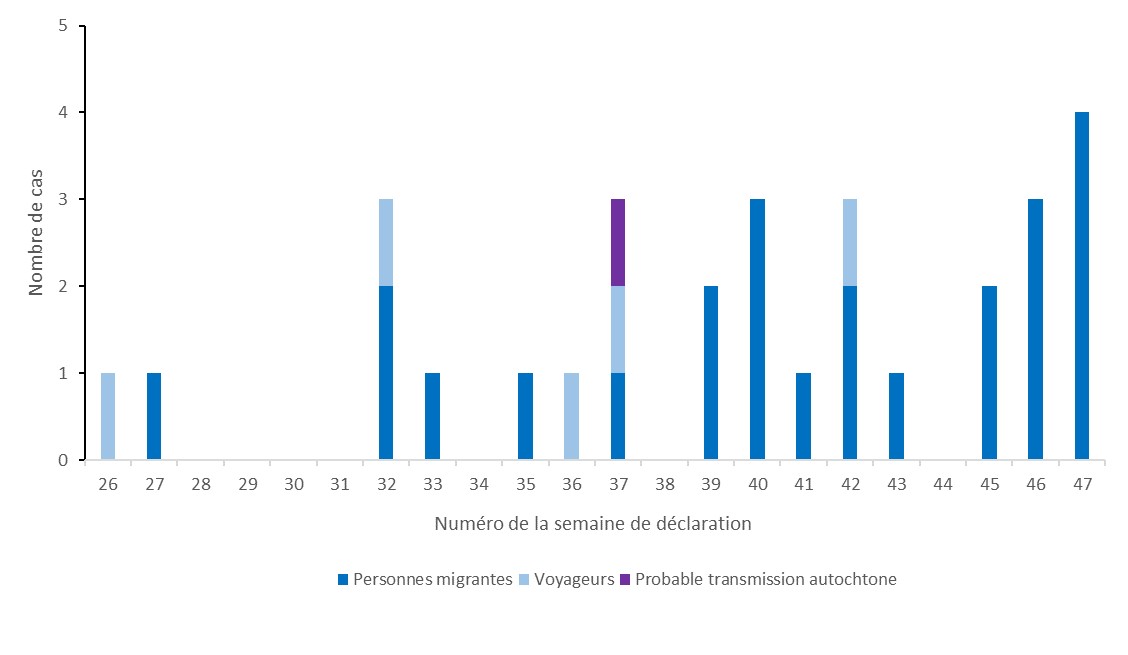
Figure 3 - Number of cases by region, France, 2022 - Data as of November 30, 2022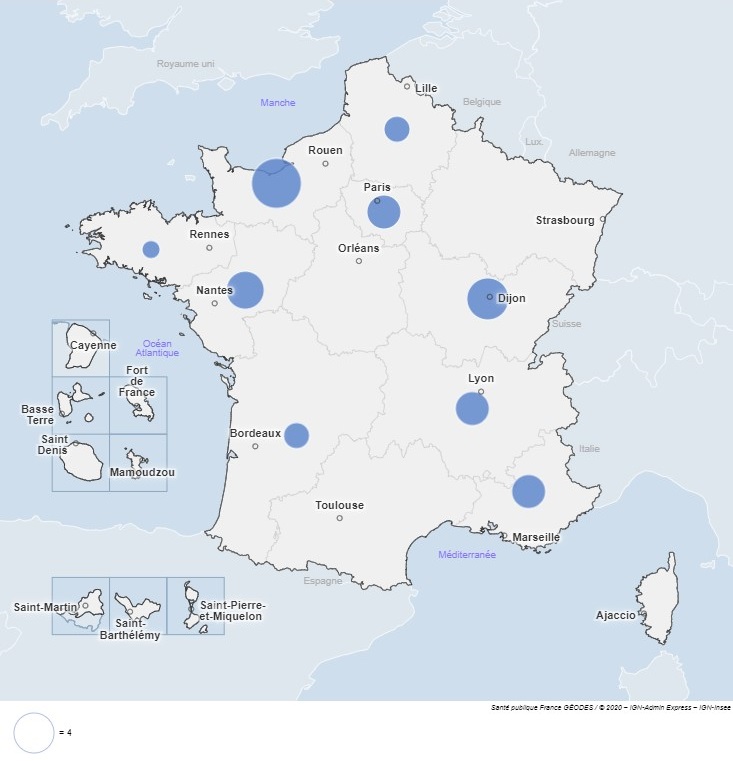
This increase in the number of cases among migrants is also observed in other European countries. As of September 26, 2022, the European Center for Disease prevention and Control (ECDC) reported 92 cases of C. diphtheriae diphtheria in 2022 in 7 European countries (Germany, Austria, Belgium, France, Great Britain, Norway, Switzerland)
Mayotte and Reunion
In Mayotte, the autochthonous circulation of the bacterium has been known for several years. In 2022, of the 13 cases reported, 7 were cutaneous forms, 1 ENT form and 5 were asymptomatic (ENT) carriers of the bacterium. These last 5 infections were discovered among close contacts of 2 symptomatic cases. One death occurred in an unvaccinated 7-month-old baby. In Reunion, over the period 2021-2022, all the cases reported were imported cases. In 2022, 4 cases were declared and no notion of travel was found. These 4 cases were apparently unrelated and were cutaneous forms.
The analysis of the genomic groupings, by the CNR, showed that 12 strains (8 in Mayotte and 4 in Reunion) had the same characteristics, which strongly suggests that these cases are linked. We have no hypothesis at this stage on the nature of this link.
What measures are in place?
In mainland France and Reunion
France has a very high vaccination coverage (VC) against diphtheria: 99% for the primary vaccination and 96% for the booster at 11 months in infants in 2019. These vaccination coverages have been very high for many years, the vaccine having been made compulsory up to the age of 13 until 2018. In addition, vaccination is compulsory for infants born from 2018. The risk of occurrence of cases, in particular serious and /or cases grouped within the general French population, therefore remains extremely low.
In Réunion, the CV is also high (97.4% for the 11-month recall in 2018). On the other hand, the increase in cases of diphtheria among migrants, the vast majority of whom are not up to date with their vaccinations, raises fears of the appearance of grouped cases of infection with C. diphtheriae in places of accommodation for migrants, refugees or asylum seekers (this scenario has been described in Switzerland, Kofler et al Eurosurveillance 2022). In order to prevent this risk, a message 1 informing of this increase in cases among migrants and recalling the recommendations for vaccination and care 2 has been sent to associations caring for migrant populations and to health professionals.
Investigations and discussions on cases occurring among migrants are carried out at European level (ECDC and WHO) in particular to identify a possible place of contamination (countries crossed on the migratory route or country of origin such as Afghanistan).
In Mayotte
In Mayotte, studies carried out over the past few years show an insufficient CV to ensure collective immunity. In 2019, 93.2% of children aged 24 to 59 months; 45.3% of 7-11 year olds and 27.1% of 14-16 year olds were up to date with their diphtheria vaccination. Interventions aimed at increasing vaccination coverage in these populations must be reinforced in this territory.
1- MINSANTE No. 2022_66 dated 09/27/2022
2- Opinion of the High Council for Public Health on the conduct to be followed around a case of diphtheria of March 4, 2011 and supplement of September 10, 2022: https:/ /www.hcsp.fr/explore.cgi/avisrapportsdomaine?clefr=215
https://www.santepubliquefrance.fr/l...france-en-2022
Increase in diphtheria cases caused by C. diphtheriae in France in 2022
Update on November 30, 2022 following cases of diphtheria caused by C. diphtheriae reported in several regions of metropolitan France as well as in Mayotte and Réunion.
Posted on December 29, 2022
Since the beginning of 2022, several cases of diphtheria have been reported in 9 regions of metropolitan France as well as in Mayotte and Réunion. Compared to other years, the number of cases of C. diphtheriae is significantly higher than average. In metropolitan France, the majority of cases were reported in migrants and travelers. Thanks to the very high vaccination coverage for many years, the occurrence of serious cases or clustered cases within the general population appears extremely low in metropolitan France and Reunion. In Mayotte, where vaccination coverage is insufficient, the bacterium has been circulating for several years.
Public Health France is monitoring the evolution of the situation and the increase in cases of diphtheria among migrants, the vast majority of whom are not up to date with their vaccinations. A reminder of vaccination and management recommendations has been sent to associations and healthcare professionals.
Reminder about illness
Diphtheria is a disease caused by bacteria ( Corynebacterium diphtheriae ). Very contagious, it is transmitted from person to person from sick subjects but also from healthy carriers (carrying possible for several weeks or months). Transmission is either direct by coughing and sneezing (via droplets), or indirect from soiled objects (rare) or untreated skin lesions. Its incubation period is short, 2 to 5 days. The signs of diphtheria are those of sore throat, with fever, swelling of the neck and headache or skin infection.
Update in France
As of November 30, 2022, 55 cases of diphtheria have been reported in France since the start of the year (figure 1):
- 8 cases of diphtheria due to Corynebacterium.ulcerans ( C. ulcerans ) in metropolitan France;
- 30 cases of diphtheria caused by Corynebacterium diphtheriae ( C. diphtheriae ) in metropolitan France;
- 13 cases of diphtheria caused by C. diphtheriae in Mayotte and 4 in Reunion.
Figure 1 - Number of reported diphtheria cases, per year, France, 2002-2022 – Data as of November 30, 2022

In France
The majority of cases were reported in migrants (n=24) but also in travelers (n=5) (Figure 2). For these 29 cases, a link was found with one or more of the following countries: Afghanistan (n=21), Turkey (n=6), Italy (n=5), Serbia (n=5), Austria (n= 4), Tunisia (n=3), Bulgaria (n=2), Iran (n=2), Hungary (n=2), Mali (n=2), Switzerland (n=2), Slovenia (n=1 ), Syria (n=1), Senegal (n=1), Thailand (n=1). When the date of their arrival in France was known (n=9), it was less than 15 days before the date of notification of the disease.
In addition, a case was probably infected on French territory during contact with a person returning from a trip to Togo.
Cases of diphtheria due to C. diphtheriae were mainly men (n=28), aged 11 to 47 years (21 years on average). Only two of them were up to date with their diphtheria vaccination. For 24 of them, the vaccination status was unknown.
Among the cases that occurred among migrants, 6 lived in a shelter.
Cases have been diagnosed in 9 regions. The Normandy region was the most affected with 7 cases reported (figure 3). Twenty-five cases were cutaneous forms, 3 were asymptomatic carriers (oropharyngeal), one was a slightly symptomatic respiratory form (autochthonous case) and another presented the symptoms of classic respiratory diphtheria (migrant person).
Two grouped cases were reported: one concerned 4 cases who had traveled together on a bus and the other two cases who had traveled together.
Genotyping of 19 isolates by the National Reference Center (CNR) for corynebacteria of the diphtheriae complex by genomic sequencing showed 5 different genetic groups: ST377a (2 cases), ST377b (1 case), ST384 (2 cases), ST574 ( 3 cases), ST698 (2 cases). These groups have also been identified in other European countries. The other isolates are being sequenced.
Figure 2 - Number of diphtheria cases caused by C. diphtheriae, by reporting week, France, 2022 – Data as of November 30, 2022

Figure 3 - Number of cases by region, France, 2022 - Data as of November 30, 2022

This increase in the number of cases among migrants is also observed in other European countries. As of September 26, 2022, the European Center for Disease prevention and Control (ECDC) reported 92 cases of C. diphtheriae diphtheria in 2022 in 7 European countries (Germany, Austria, Belgium, France, Great Britain, Norway, Switzerland)
Mayotte and Reunion
In Mayotte, the autochthonous circulation of the bacterium has been known for several years. In 2022, of the 13 cases reported, 7 were cutaneous forms, 1 ENT form and 5 were asymptomatic (ENT) carriers of the bacterium. These last 5 infections were discovered among close contacts of 2 symptomatic cases. One death occurred in an unvaccinated 7-month-old baby. In Reunion, over the period 2021-2022, all the cases reported were imported cases. In 2022, 4 cases were declared and no notion of travel was found. These 4 cases were apparently unrelated and were cutaneous forms.
The analysis of the genomic groupings, by the CNR, showed that 12 strains (8 in Mayotte and 4 in Reunion) had the same characteristics, which strongly suggests that these cases are linked. We have no hypothesis at this stage on the nature of this link.
What measures are in place?
In mainland France and Reunion
France has a very high vaccination coverage (VC) against diphtheria: 99% for the primary vaccination and 96% for the booster at 11 months in infants in 2019. These vaccination coverages have been very high for many years, the vaccine having been made compulsory up to the age of 13 until 2018. In addition, vaccination is compulsory for infants born from 2018. The risk of occurrence of cases, in particular serious and /or cases grouped within the general French population, therefore remains extremely low.
In Réunion, the CV is also high (97.4% for the 11-month recall in 2018). On the other hand, the increase in cases of diphtheria among migrants, the vast majority of whom are not up to date with their vaccinations, raises fears of the appearance of grouped cases of infection with C. diphtheriae in places of accommodation for migrants, refugees or asylum seekers (this scenario has been described in Switzerland, Kofler et al Eurosurveillance 2022). In order to prevent this risk, a message 1 informing of this increase in cases among migrants and recalling the recommendations for vaccination and care 2 has been sent to associations caring for migrant populations and to health professionals.
Investigations and discussions on cases occurring among migrants are carried out at European level (ECDC and WHO) in particular to identify a possible place of contamination (countries crossed on the migratory route or country of origin such as Afghanistan).
In Mayotte
In Mayotte, studies carried out over the past few years show an insufficient CV to ensure collective immunity. In 2019, 93.2% of children aged 24 to 59 months; 45.3% of 7-11 year olds and 27.1% of 14-16 year olds were up to date with their diphtheria vaccination. Interventions aimed at increasing vaccination coverage in these populations must be reinforced in this territory.
1- MINSANTE No. 2022_66 dated 09/27/2022
2- Opinion of the High Council for Public Health on the conduct to be followed around a case of diphtheria of March 4, 2011 and supplement of September 10, 2022: https:/ /www.hcsp.fr/explore.cgi/avisrapportsdomaine?clefr=215
https://www.santepubliquefrance.fr/l...france-en-2022
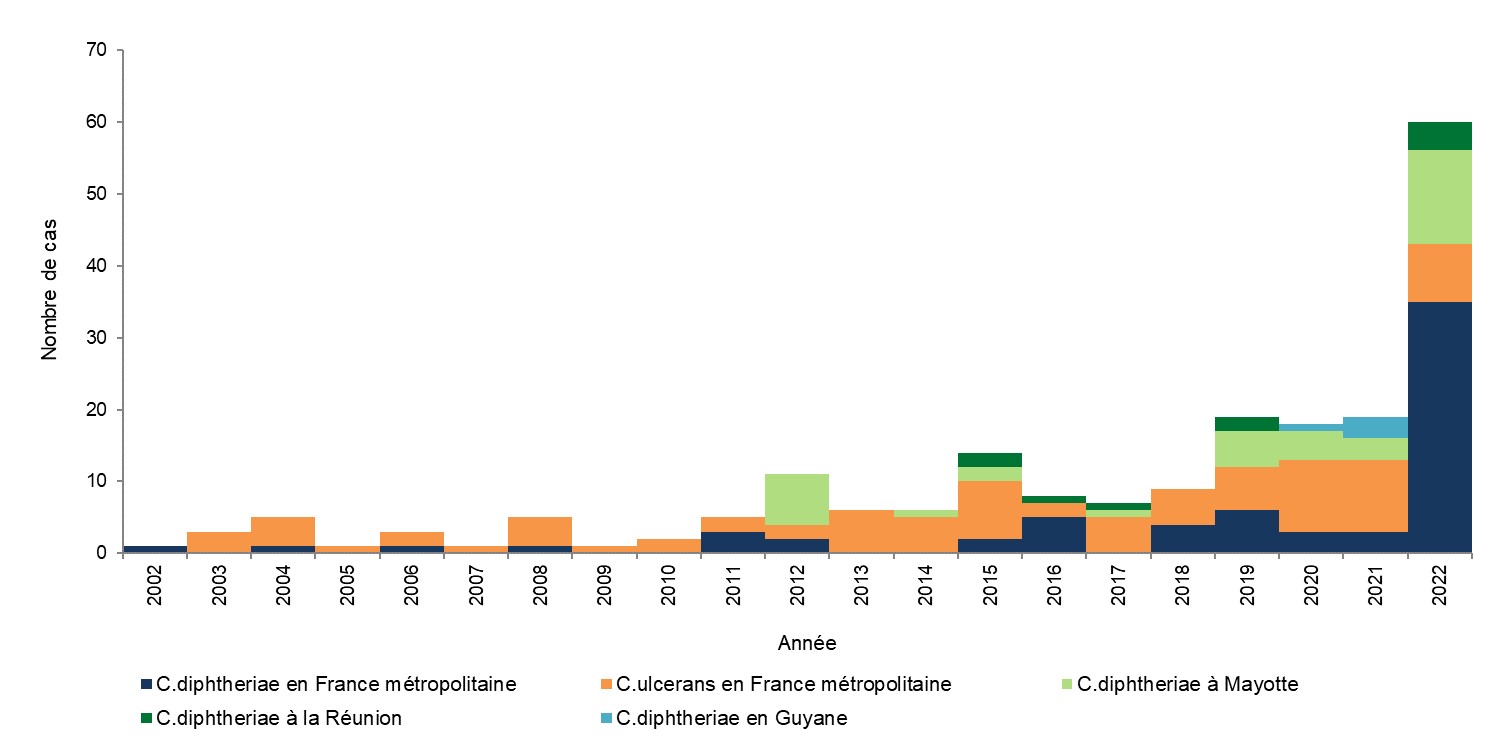
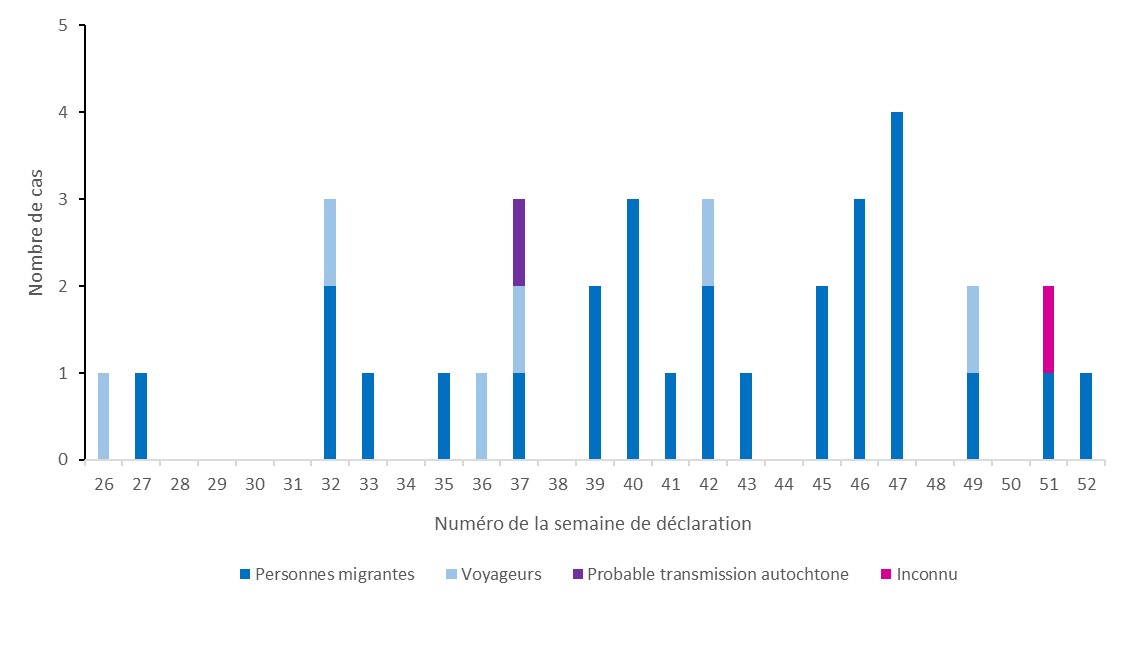
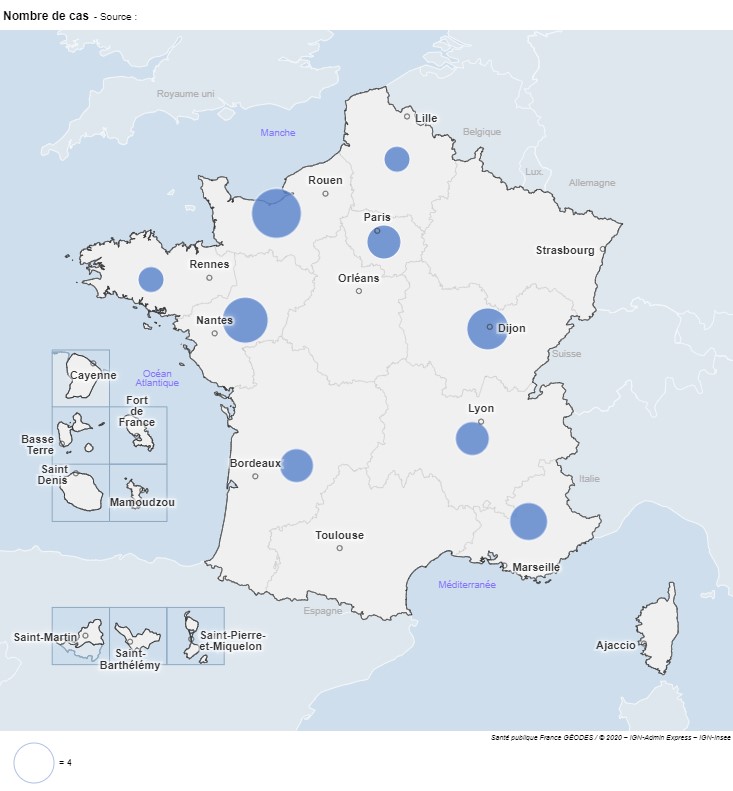
Comment